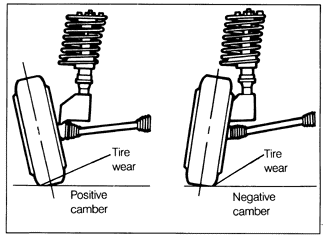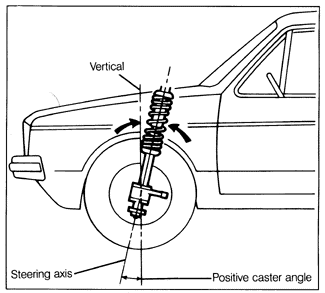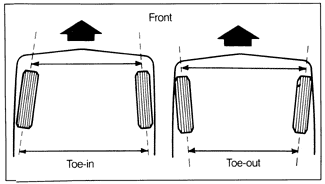4.2 AlignmentWheel alignment is the precise adjustment of wheel angles, used to achieve the best compromise between comfort, control, and tire wear. Alignment specifications differ from model to model, depending on suspension design. The alignment can also be fine-tuned for specific driving conditions. For example, if the car consistently carries only one person, or is consistently heavily loaded, this information will be useful to the alignment technician. Like tire pressure, wheel alignment also has some influence on fuel economy, because of the effect on rolling resistance. The important alignment angles are camber, caster, and toe. Camber is the angle that the wheels tilt from vertical when viewed from front or rear, as illustrated in Fig. 4-1. Wheels which tilt out at the top have positive (+) camber. Wheels which tilt in at the top have negative (-) camber. On the Volkswagens covered by this manual, camber adjustment is not normally required, although there are provisions for making camber adjustments if necessary. See Camber Adjustment. Camber influences cornering, directional stability, and tire wear. Different camber on the two front wheels may cause the car to pull to one side. Misadjusted camber will cause uneven tire wear.

Caster, the angle by which the steering axis deviates from vertical, is illustrated in Fig. 4-2. The steering axis is an imaginary line about which the front wheels turn. Most cars are designed with a steering axis which is inclined toward the rear at the top (positive caster), giving them directional stability and self-centering steering. Caster should be checked as part of any alignment. It is not, however, an adjustable angle on cars covered by this manual. Caster which is out of specification suggests worn or damaged components. Uneven front wheel caster will cause the car to pull to one side. Too little caster reduces directional stability. Too much caster increases turning effort.

Toe is a measurement of the amount that two wheels point toward each other (toe-in) or away from each other (toe-out), as viewed from above or below. Toe-in and toe-out are illustrated in Fig. 4-3. Toe affects directional stability and tire wear, and at the front wheels also has some effect on how the car responds to steering changes. Toe is the primary alignment adjustment for cars covered by this manual. See Toe Adjustment for information on adjusting toe. Too much toe will cause the tires to "scrub" and to wear unevenly and more quickly. Too little toe-too near zero-may cause the car to be less stable and wander from side to side.

Because of the emphasis on precision, wheel alignment has become very sophisticated. Modern computerized equipment, using special optics or laser beams for measurement, help the qualified technician do the job more quickly and more accurately than is possible for the do-it-yourselfer. For this reason, this manual covers only the specific adjustment methods, and not the basic procedures for measuring wheel alignment angles. The reasonable cost of a professional wheel alignment is money well spent. |